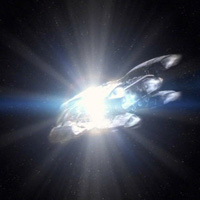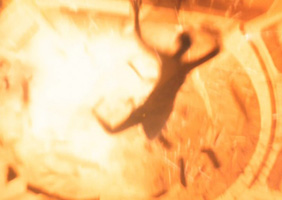 This is the fifth installment in my series on the different flavors of FTL, and this week we’re jumping into… well, jumps. A jump is essentially teleportation over interstellar distances. You set your destination coordinates, hit the switch, and then you’re at the destination. In some stories, these jumps are instantaneous. In others, the jump takes time while you exist in some transitory null-space. That second variation might sound a lot like hyperspace, but the distinction between jumps and hyperspace are in the details.
This is the fifth installment in my series on the different flavors of FTL, and this week we’re jumping into… well, jumps. A jump is essentially teleportation over interstellar distances. You set your destination coordinates, hit the switch, and then you’re at the destination. In some stories, these jumps are instantaneous. In others, the jump takes time while you exist in some transitory null-space. That second variation might sound a lot like hyperspace, but the distinction between jumps and hyperspace are in the details.
One thing about jumping, though, is that the terminology is much sloppier than for other flavors. For example, the Dune universe used jumping, though they didn’t call it that. It was “folding space”, but it was functionally the same kind of interstellar teleportation that I’m describing here. Star Wars muddies the water further by talking about “jumping through hyperspace”, making it unclear which of the two flavors they’re using. This flavor is the furthest from known physics, so it’s understandable that it has the most hand-waving and distracting terms.
FTL-to-FTL Interactions: There are none. If the jump is instant, there is simply no time, but if even it takes a few days or weeks, the ship is not in any kind of recognizable space. You can’t see other ships, so you can’t interact with them.
FTL-to-sublight interactions: There are none. Again, if it’s instantaneous, there’s no time for such interactions, and even if it takes time, your ship is completely cut off from the rest of Einsteinian space.
Relativistic effects: If the jump is instant, there are one. If it takes time, I have typically seen it take the same amount of time on ship as it did in regular space. However, I don’t see this time match-up as a hard rule for this flavor of FTL.
In-FTL Navigation: There is none. All of your navigation choices were set before the jump. After that, you are simply waiting to land. This is probably the biggest distinction between jumps and the hyperspace flavor. Hyperspace typically allows at least some kind of in-FTL navigation, even if it’s merely to stop short and drop back to normal space.
Speed Differential: Yes, there can be speed differences but not in the normal sense. After all, my instant jump cannot be any faster than your instant jump, but it is possible for my jump to be of a greater distance than yours. I jumped to Sirius in one jump, but you require four shorter jumps. That speed differential is a fairly common one in both fiction and space-based RPGs.
Another speed differential with jumping can be in the time it takes to figure out all those jump coordinates. This is less about the drive itself and more about navigational sensors and computation power, but it still impacts the overall speed of a series of jumps strung together. Similarly, it can take time to refuel or recharge the jump drives. So, not only do these jump delays allow two similarly-rated ships to have different overall speeds, but they further penalize any ship that has to do a series of shorter jumps.
Furthermore, jump accuracy makes a big difference in the final planet-to-planet travel times. Does your jump drop you out at the edge of the star system? In the neighborhood of the planet? Or can you plop yourself down in the atmosphere on a landing path to the starport? The further out you are, the longer you’ll spend travelling at sublight speeds to finish off the journey. Similarly, some jump systems don’t work well in gravitational fields, so it’s necessary to travel a ways out before making your jump in the first place. Put those together, and drive accuracy and stability can add days or weeks to your journey.
Now, for those jumps that actually do take time, we get into speed differences that are much more familiar. How long does a jump take? Is it the same for all jumps? Does it get longer the further you go? Maybe some ships can jump five light years in a day while others take a week. This kind of variation is fairly rare in stories I’ve seen, but I would not say it’s disallowed by the general flavor of jumps. It’s just another tweak.
Malfunctions: These tend to be either errors of navigation or fatal disasters. Sloppy navigation could be from miscalculating those jump coordinates, but they could just as easily come from some mechanical failure in the jump drive itself. I can see the jump-drive equivalent of Scotty shouting to the bridge, “Aye, her core filters are as twisted as the Admiral’s knickers!” Still, the worst that has happened is that you ended up somewhere other than where you meant to land, and space is 99.999… some more 9’s … 99% empty space. Very likely, you won’t have landed inside anything nasty.
 On the other hand, if “her core filters” are as twisted as Scotty says, they might just blow up when you hit the switch, especially if you’re too close to a planet, moving too fast, or anything else that makes a jump tricky. Who knows what would cause it, but when enough energy to teleport the ship five or ten light years goes awry, it’s not a healthy place to be.
On the other hand, if “her core filters” are as twisted as Scotty says, they might just blow up when you hit the switch, especially if you’re too close to a planet, moving too fast, or anything else that makes a jump tricky. Who knows what would cause it, but when enough energy to teleport the ship five or ten light years goes awry, it’s not a healthy place to be.
And finally, there’s the possibility of jumping but never landing. These ships get lost in that transitory null-space, and we never hear from them again. Or do we? I’ve seen a few tales of the Flying Dutchman’s space cousin, and even one where they managed to recover them.
Special traits: A common feature I’ve see with jump drives is that they are reserved for larger ships, not little one-man fighters. This isn’t universal, but it’s common enough to note. Another feature I’ve seen crop up is the idea of jump points, i.e. fixed points in space where the local conditions are ideal for a jump. Those fixed points can add to the fun of space opera because they make space suddenly small again. The star system might be billions of kilometers across, but there are only four usable jump points. If you’re defending against an invasion or hunting unsuspecting merchants, those are the places you want to stake out.
That’s the end of the flavors. Tune in next week for a recap, some comparisons, and ideas that could point to as-yet-unsampled flavors.
The whole series: Intro, Warp Drive, Hyperspace, Wormholes, Jumping, Summary
